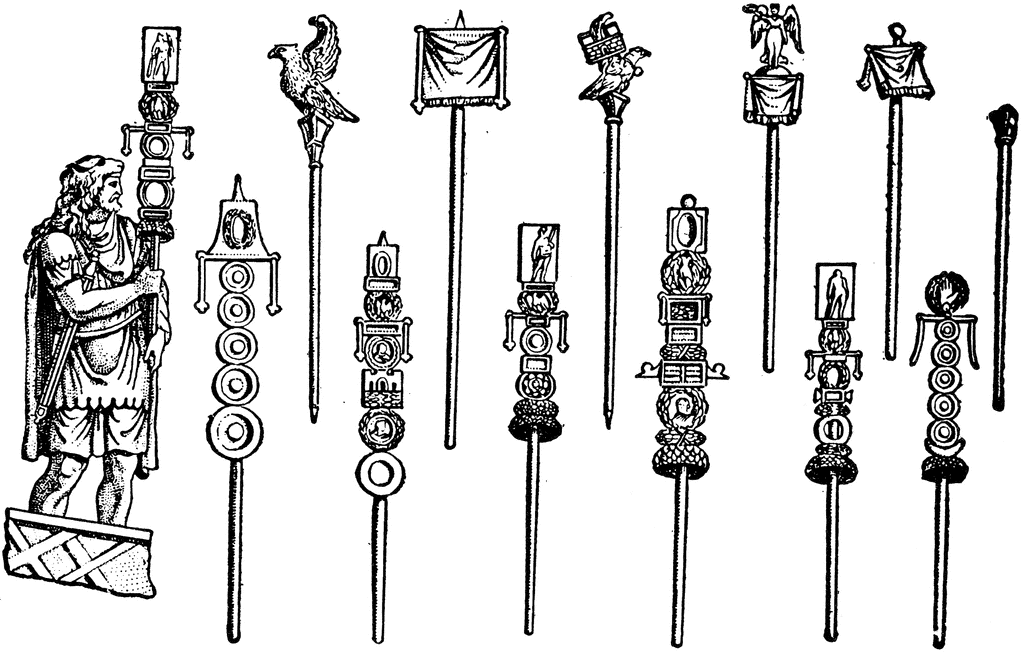在现代军队中,除了军团的颜色之外,没有任何东西可以与罗马标准(signa)相提并论。 它们发挥着识别信号和集结点的作用。 军队单位需要一个设备,以便在战斗中观察和跟踪,士兵们也需要一眼就能认出他们自己。
罗马标准被视为一种敬畏,它们是罗马荣誉的象征,以至于为了找回丢失的标准,罗马领导人可能会开展运动。 例如,为了找回瓦鲁斯在特托堡森林丢失的标准,对德国人发起了一场特殊的运动。
See_also: 罗马标准 标准在投掷和打击营地方面也发挥了重要作用。
营地选好后,第一件事就是把标杆的尖头插入地下,建立起标杆。 当营地扎好后,用伸出的大把手把标杆拔出来。 如果标杆牢牢扎在地上,就会被认为是一个严重的预兆,人们甚至会拒绝移动,说是神灵要他们留在那里。
在军队严格遵守的许多宗教节日中,标准也发挥了重要作用。 在这些场合,他们用珍贵的油膏涂抹,用花环装饰,可能还会加上特殊的战斗荣誉和月桂花环。 有人说军队实际上崇拜他们的标准,这并不令人惊讶。
在战线上,标兵有关键的位置,这一点从凯撒那里可以看出,他经常提到前标兵和后标兵,他们是标兵前后的部队。
与标准有关的命令也被用于运动,如在非洲,在一次交战中,部队变得混乱,被命令不得超过其标准的四英尺。
另一个重要的功能是在战场上的信号系统。 命令是通过标准器和号手,即科尔尼琴来传达的。 科尔尼琴的爆炸声将士兵们的注意力吸引到他们的标准器上,在那里他们将跟随队列。 通过上下或摇摆的动作发出有限的信号,表示对预先安排的命令。级别。
当人们谈到标准器本身及其在整个帝国时代的各种类型和模式时,目前的知识存在一些严重的空白。 不过可以假设,罗马军团从最早的时候就开始使用动物标准器,而且它们逐渐变得合理。
历史学家普林尼(Pliny the elder)认为共和国有五种标准:鹰、狼、牛头人、马和野猪。 马略(Marius)将鹰作为最高标准,因为它与朱庇特(Jupiter)关系密切,其余的都被降级或废除了。 在共和国后期,鹰标(aquila)是银制的,鹰爪中握着一个金雷电。后来,它完全由黄金制成,并由高级标准携带者,即水手携带。
See_also: 瓦鲁纳:印度教的天空和水神 鹰标上有著名的罗马字母缩写SPQR。 这些字母代表senatus populusque romanus,意思是 "元老院和罗马人民"。 因此,这个标准代表了罗马人民的意愿,并说明士兵是代表他们行事的。 SPQR的缩写在帝国的历史上一直是一个强有力的象征,因为元老院仍然是被视为(理论上)帝王时代的最高权威。
虽然鹰是所有军团的共同标志,但每个部队都有几个自己的标志。 这些标志通常与部队或其创始人的生日有关,或者与在其手下取得特定胜利的指挥官有关。 这些标志是黄道十二宫的标志。 因此,公牛标志着4月17日至5月18日,这段时间是朱利安家族的母神维纳斯的神圣节日;同样,公牛标志着摩羯座是奥古斯都的标志。
因此,英国军团之一的奥古斯塔二世展示了摩羯座,因为它的名字表明它是由奥古斯都建立的。 此外,奥古斯塔二世还带有飞马和火星的标志。 尤其是火星的标志,更可能意味着在危险时期对战神的某种宣誓。
伊玛格是一种特别重要的标准,它使皇帝与他的军队关系更加密切。 这种印有皇帝形象的标准由想象师携带。 在后来,它也有统治者的其他成员的肖像。
阿奎拉(aquila)和伊马格(imago)是对第一队的特别照顾,但每个世纪都有其他标准。 操纵队是一个非常古老的军团部门,由两个世纪组成。 对于这个部门,也有一个标准。 罗马人自己似乎没有关于这个标准的起源的信息,它应该是来自一根带着一把稻草绑在上面。
这个标准顶部的手(manus)有一定的意义,尽管后来的罗马人自己可能并不了解。 军礼? 神圣的保护? 手下面是一个横杆,上面可以挂上花环或花片,在杖上垂直排列着带有数字的圆盘。 这些数字的确切意义不为人知,但它们可能是已表明该组群、世纪或操纵的数字。
与现代旗帜最相似的标准是vexillum,它是一块小的方形布片,连接在一根杆子上。 这是一种更常见的骑兵标准,阿拉的高级标准持有者被称为vexillarius。 不同颜色的布片可以挂在vexillum上,红色的旗子表示战斗即将开始。
最后应该指出的是,标准器的持有者在制服外穿上了兽皮。 这遵循了凯尔特人的惯例。 例如,苏比人就戴着野猪的面具。 兽头被带在持有者的头盔上,所以实际上可以看到额头上的牙齿。

James Miller
James Miller is an acclaimed historian and author with a passion for exploring the vast tapestry of human history. With a degree in History from a prestigious university, James has spent the majority of his career delving into the annals of the past, eagerly uncovering the stories that have shaped our world. His insatiable curiosity and deep appreciation for diverse cultures have taken him to countless archaeological sites, ancient ruins, and libraries across the globe. Combining meticulous research with a captivating writing style, James has a unique ability to transport readers through time. James' blog, The History of the World, showcases his expertise in a wide range of topics, from the grand narratives of civilizations to the untold stories of individuals who have left their mark on history. His blog serves as a virtual hub for history enthusiasts, where they can immerse themselves in thrilling accounts of wars, revolutions, scientific discoveries, and cultural revolutions.Beyond his blog, James has also authored several acclaimed books, including From Civilizations to Empires: Unveiling the Rise and Fall of Ancient Powers and Unsung Heroes: The Forgotten Figures Who Changed History. With an engaging and accessible writing style, he has successfully brought history to life for readers of all backgrounds and ages.James' passion for history extends beyond the writtenword. He regularly participates in academic conferences, where he shares his research and engages in thought-provoking discussions with fellow historians. Recognized for his expertise, James has also been featured as a guest speaker on various podcasts and radio shows, further spreading his love for the subject.When he's not immersed in his historical investigations, James can be found exploring art galleries, hiking in picturesque landscapes, or indulging in culinary delights from different corners of the globe. He firmly believes that understanding the history of our world enriches our present, and he strives to ignite that same curiosity and appreciation in others through his captivating blog.



